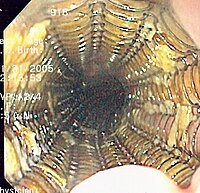
Photo from wikipedia
BACKGROUND AND AIMS Little medical literature exists for the use of fully covered self-expanding metal stents (CSEMSs) in the management of retained common bile duct (CBD) stones. Our aim was… Click to show full abstract
BACKGROUND AND AIMS Little medical literature exists for the use of fully covered self-expanding metal stents (CSEMSs) in the management of retained common bile duct (CBD) stones. Our aim was to assess the safety and efficacy of CSEMSs for the indication of retained "difficult" CBD stones. METHODS This retrospective cases series included 44 patients (30 women; median age, 69 years [range, 24-88]) who underwent CSEMS insertion for the indication of retained "difficult" CBD stones in 2 tertiary referral centers. Patients underwent temporary placement of CSEMSs after incomplete stone clearance at ERCP. Follow-up ERCP was arranged for stent removal and subsequent attempt at duct clearance. Procedure-related adverse events were also recorded. RESULTS Successful biliary drainage was achieved in all cases after CSEMS placement. Forty-two stents were removed with successful duct clearance achieved in 36 cases (82%) after a median in-stent duration of 8 weeks. There were 10 cases (22.7%) of stent migration, all noted incidentally during follow-up. One patient died of nonbiliary causes before attempted removal. CONCLUSION This is the largest published retrospective case series for use of CSEMSs for management of retained CBD stone disease to date. We have shown high success rates for this indication. A well-designed, multicenter, randomized controlled trial might address the uncertainty of cost-to-benefit ratio and appropriate duration for CSEMSs to be left in situ. Specific stent modification for this indication, including wider distal flare and retrieval purse string loop, may also be useful.
Journal Title: Gastrointestinal endoscopy
Year Published: 2017
Link to full text (if available)
Share on Social Media: Sign Up to like & get
recommendations!